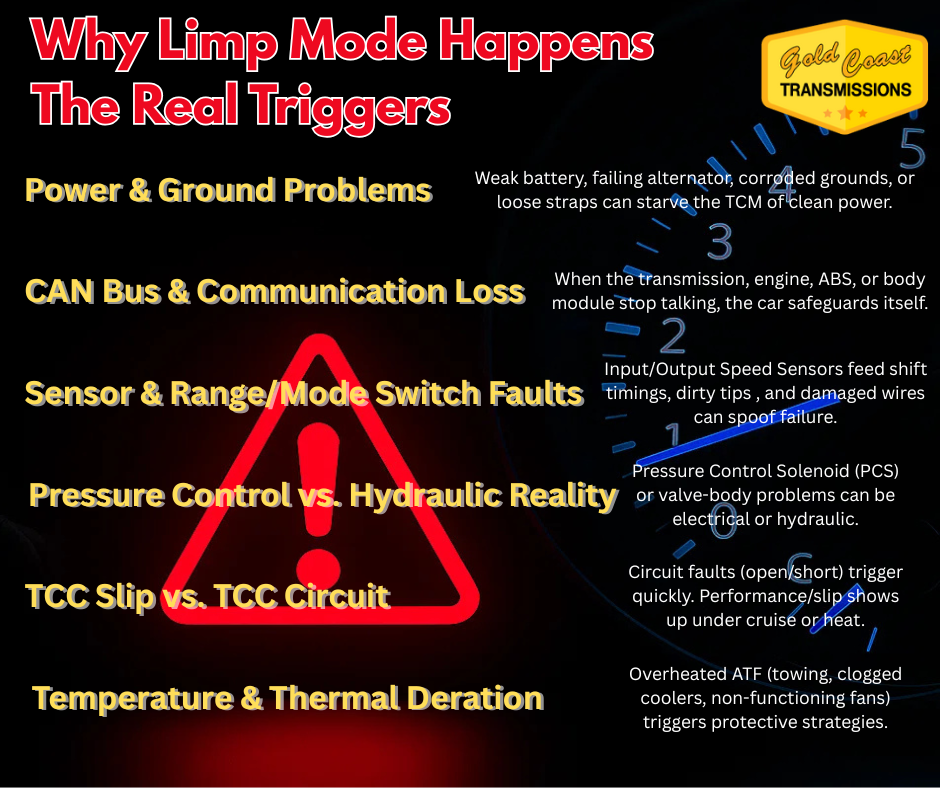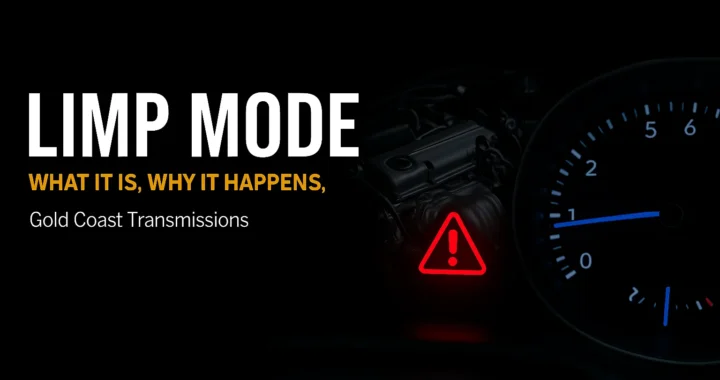You’re cruising, then all of a sudden, your car won’t shift. It’s stuck in one gear, and the dash lights up like a Christmas tree. That’s limp mode. It sounds catastrophic, but it’s your vehicle’s way of protecting the powertrain until a proper diagnosis can be done.
Here’s how limp mode works, what commonly triggers it, and how we separate a real fix from an expensive misdiagnosis.
What Limp Mode Is (and Isn’t)
It is: A built-in failsafe strategy for your vehicle. The control modules (PCM/TCM) detect a fault and lock the car into a limited operating state—typically 2nd or 3rd gear, reduced power, no overdrive/TCC lockup—so you can get to safety or a shop.
It isn’t: An automatic death sentence for your transmission. Many limp mode cases trace back to electrical, sensor, or communication problems—not a destroyed transmission.
Quick Triage: What To Do
Ease off. Don’t force highway speeds when driving in limp mode—keep it gentle and steady.
Restart once, safely. Some platforms clear limp on key cycle; if it returns, stop guessing.
Note the symptoms. Stuck gear? Flashing PRNDL? Erratic speed? Take a photo of the dashboard and signs.
Call us. We’ll book a full diagnostic and explain findings in plain English.
Why Limp Mode Happens: The Real Triggers
Power & Ground Problems (The Hidden Culprit)
- A weak battery, a failing alternator, corroded grounds, or loose straps can starve the TCM of clean power.
- Symptoms: PRNDL flashing, random “U-codes,” harsh engagements, and modules dropping offline.
- Want the bigger picture? See how electrical issues affect your transmission.
CAN Bus & Communication Loss
- Modern cars are networks. If the transmission, engine, ABS, or body module stop talking, the car safeguards itself.
- Clues: Multiple warning lights, scan tool shows “Lost Comm” with TCM/ABS/BCM.
- We verify by comparing wheel speed (ABS), output speed, and vehicle speed live.
Sensor & Range/Mode Switch Faults
- Input/Output Speed Sensors (ISS/OSS) feed shift timing; dirty tips, broken reluctors, or damaged wires can spoof failure.
- Range/Mode (PRNDL/IMS) reporting the “wrong” gear will force failsafe.
- Paired issues with MAF/TPS/ECT can trick the transmission into bad timing decisions.
Pressure Control vs. Hydraulic Reality
- Pressure Control Solenoid (PCS) or valve-body problems can be electrical (coil/driver) or hydraulic (stuck valves, varnish, debris).
TCC Slip vs. TCC Circuit
- Circuit faults (open/short) trigger quickly; performance/slip shows up under cruise or heat.
- Low voltage can mimic TCC slip; a converter isn’t guilty just because a code says “TCC.”
Temperature & Thermal Derate
- Overheated ATF (towing, clogged coolers, non-functioning fans) triggers protective strategies.
- A false “overheat” signal from a damaged TFT circuit can also force limp.
- Related deep dive: What happens when coolant or water hits your transmission circuits?

Misdiagnosis: Why Parts Swapping Fails
Codes point to where a problem was detected—not always why. Replacing a sensor, solenoid, valve body, or even the whole transmission without power/ground checks, network testing, and pressure verification is how people spend thousands and still limp home.
How We Diagnose Limp Mode (Our Playbook)
Power & Charging Check
Clean 12.6V off / 13.8–14.4V running. If the voltage is wrong, everything after is noise.
Scan All Modules + Freeze-Frame
We don’t stop at the engine/trans. ABS, body, and gateway modules tell the network story.
Harness & Connector Inspection
We’re looking for ATF wicking through connector sleeves, water intrusion, chafed looms, and green crust on pins.
Live Data + Commanded Tests
Compare commanded vs. actual line pressure, ISS/OSS plausibility, TCC slip trends, and gear ratio math.
Hydraulic Verification
If electronics pass, we test hydraulics (manual pressure gauge, stall test, adaptation status).
Software Updates & Relearns
After repair, we perform TCM/PCM updates and adaptive relearns—skipping this causes fresh harsh shifts and “new” codes.




